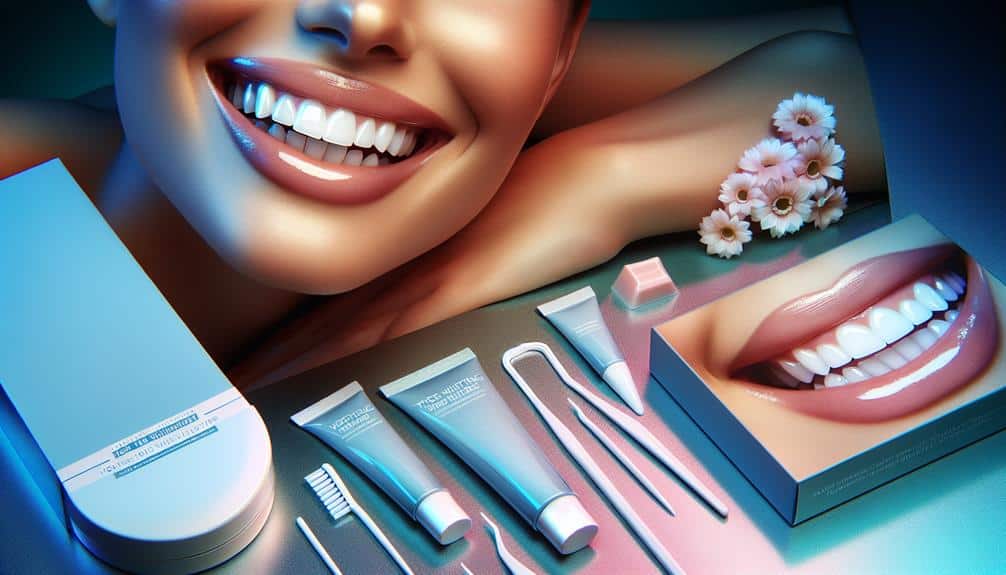Guarantee the safety of your teeth with FDA-approved whitening strips by following these top 5 safety tips: Pay attention during application to avoid contamination and ensure even coverage; monitor sensitivity levels by starting slowly and adjusting as needed; strictly adhere to manufacturer's guidelines to prevent misuse and potential side effects; and consult with a dental professional for personalized advice on achieving a brighter smile while maintaining good oral health. Prioritizing safety and efficacy is key for a successful whitening experience.
Key Points
- Follow proper application technique for even coverage and adherence.
- Monitor sensitivity levels to adjust whitening duration for comfort.
- Adhere strictly to recommended guidelines to avoid misuse and side effects.
- Consult a dental professional for personalized advice and monitoring.
- Consistency in usage maximizes safety and effectiveness of whitening strips.
Understanding FDA Approval
To understand FDA approval for whitening strips, it's crucial to grasp the rigorous process these products undergo before reaching the market. The FDA regulates these products to guarantee their safety and efficacy. Before any whitening strip can be sold to consumers, it must go through a series of tests and evaluations to prove its effectiveness in whitening teeth without causing harm. The FDA reviews data from clinical trials conducted by the manufacturers to determine if the product delivers the desired whitening results as claimed.
FDA regulations require that whitening strips meet strict criteria for both safety and effectiveness. This includes ensuring that the product doesn't damage tooth enamel or cause sensitivity issues when used as directed. Companies must provide substantial evidence to demonstrate the product's ability to whiten teeth effectively without compromising oral health. By adhering to these regulations, the FDA aims to safeguard consumers from potentially harmful products while ensuring that they receive the benefits they expect from whitening strips.
Proper Strip Application Technique
For effective results when using FDA-approved whitening strips, mastering the proper technique for applying the strips is crucial. Proper application guarantees even coverage and maximizes the whitening effects on your teeth.
To begin, carefully remove the strip from its packaging, making sure not to touch the gel side with your fingers to prevent contamination. Place the strip on your teeth, starting from the bottom and working your way up. Gently press the strip against your teeth, ensuring it adheres properly. Use your fingers to smooth out any air bubbles and ensure full contact between the strip and your teeth.
Once both the upper and lower strips are in place, avoid touching them with your tongue or lips to prevent them from moving around. Leave the strips on for the recommended time, usually around 30 minutes, and then carefully remove them to reveal your newly whitened smile.
Mastering this proper strip application technique will help you achieve consistent and satisfying results every time.
Monitoring Sensitivity Levels
Monitoring the sensitivity levels of your teeth while using FDA-approved whitening strips is vital to ensure a comfortable whitening experience. Sensitivity management is essential in ensuring that you achieve the desired results without causing unnecessary discomfort. It's recommended to start by using the whitening strips for a shorter duration initially and gradually increase the time if your teeth tolerate it well. If you experience any sensitivity or discomfort during or after the whitening process, it's advisable to take a break and consult with your dentist.
Long term effectiveness of whitening strips can be optimized by paying attention to your teeth's sensitivity levels. By monitoring how your teeth react to the whitening strips, you can tailor your whitening routine to suit your individual needs. This proactive approach not only enhances the comfort of the whitening process but also contributes to the overall success of your whitening treatment. Remember, your comfort and oral health should always be a top priority when using whitening strips.
Adhering to Usage Guidelines
Maintaining consistency in following the recommended usage guidelines for FDA-approved whitening strips is key to maximizing their effectiveness and guaranteeing a safe whitening process. To avoid misuse, it's essential to adhere strictly to the instructions provided by the manufacturer. Overuse can lead to tooth sensitivity and gum irritation, so it's important to resist the temptation to exceed the recommended duration or frequency of use.
Most whitening strips are designed for daily use over a specific period, typically ranging from 7 to 14 days. Skipping days or using the strips more frequently than directed won't speed up the whitening process and may instead harm your oral health.
To prevent overuse, always check the packaging or product insert for specific guidelines on how long to wear the strips and how often to apply them. Following these instructions diligently will help you achieve the desired results without compromising the safety of your teeth and gums. Consistent adherence to the recommended guidelines will ensure a successful and risk-free whitening experience.
Consulting a Dental Professional
To guarantee the safety and effectiveness of your whitening strip regimen, it's recommended to seek guidance from a qualified dental professional. When it comes to oral health and whitening treatments, a dental professional's advice can make a significant difference in achieving the desired results without compromising your oral health. Here are some reasons why consulting a dental professional is essential:
- Customized Recommendations: A dental professional can assess your oral health status and provide personalized advice on the most suitable whitening strips for you.
- Monitoring Potential Side Effects: They can help monitor any potential side effects that may arise during the whitening process and provide timely interventions to address them.
- Ensuring Long-Term Oral Health: Professional advice ensures that your whitening regimen aligns with your overall oral health goals, preventing any unintentional damage to your teeth and gums.
Frequently Asked Questions
Are There Any Specific Dietary Restrictions to Follow While Using Whitening Strips?
Just like a car needs the right fuel to run, your body thrives with good nutrition. While using whitening strips, focus on balanced meals for best results. Dietary considerations matter for overall effectiveness.
Can Whitening Strips Be Used on Dental Work Such as Crowns or Veneers?
When considering whitening strips on crowns or veneers, be cautious about dental sensitivity. These strips are usually safe for cosmetic dentistry, but consult your dentist first. They can impact the color of natural teeth differently.
How Long Should One Wait Before Consuming Food or Beverages After Using Whitening Strips?
After using whitening strips, wait at least 30 minutes before eating or drinking to optimize results. To prevent tooth sensitivity, avoid consuming acidic or staining foods/beverages immediately after. Following this waiting period guarantees effectiveness and minimizes sensitivity risks.
Are There Any Age Restrictions for Using Fda-Approved Whitening Strips?
When it comes to age restrictions for whitening strips, most FDA-approved products are safe for adults. Always check the packaging for specific guidelines. Remember, the effectiveness of whitening strips may vary based on individual factors such as age and dental health.
Can Whitening Strips Be Used by Pregnant or Breastfeeding Women?
During pregnancy or breastfeeding, safety concerns exist about using whitening strips. Consult your healthcare provider before using them. While the product is effective for teeth whitening, it's essential to prioritize the health of you and your baby.




